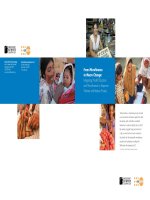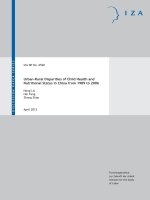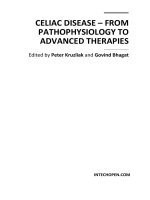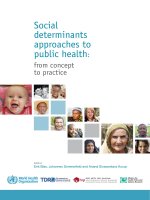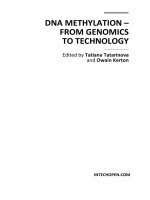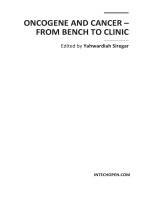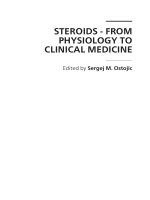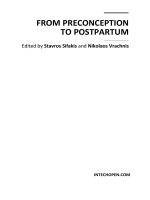Antimicrobial drug discovery: Evident shifting from terrestrial to marine micro-organisms
Bạn đang xem bản rút gọn của tài liệu. Xem và tải ngay bản đầy đủ của tài liệu tại đây (150.69 KB, 6 trang )
Int.J.Curr.Microbiol.App.Sci (2017) 6(5): 2322-2327
International Journal of Current Microbiology and Applied Sciences
ISSN: 2319-7706 Volume 6 Number 5 (2017) pp. 2322-2327
Journal homepage:
Review Article
/>
Antimicrobial Drug Discovery: Evident Shifting from
Terrestrial to Marine Micro-organisms
R.D. Singh*, S.K. Mody, H.B. Patel, Sarita Devi, V.N. Sarvaiya,
H.A. Patel and B.R. Patel
Department of Pharmacology and Toxicology, CoVSc and AH, SDAU,
Sardarkrushinagar, Gujarat -385506, India
*Corresponding author
ABSTRACT
Keywords
Antimicrobial
drugs,
Marine
bioprospecting,
Marine drug
discovery,
Micro-organisms.
Article Info
Accepted:
25 April 2017
Available Online:
10 May 2017
Marine derived micro-organisms secrete precious bioactive molecules in
traceable amount as their secondary metabolites. These bio-molecules can
be developed into antimicrobial agents, using modern tools of molecular
biology and drug discovery. Exhaustion of terrestrial sources and demand
of newer class of antibiotics due to ever-increasing resistance level in
existing antimicrobial drugs, led a paradigm shift from land to ocean for
discoveries of such agents. Marine bacteria, fungi and algae are potential
sources of novel antimicrobial drugs. Many such agents are identified
worldwide including India. Huge cost of marine bioprospecting and nonculturability of marine microbes are the major hurdles in marine drug
development which emphasized need of public-private partnerships and
advanced technologies like metagenomic tools, genetic recombinant
techniques and chemoenzymatic synthesis.
Introduction
Ocean, the mother of origin of life, covers
over 70% of the earth’s surface and hosts
approximately 87% of the Earth’s life (Hu et
al., 2011). Marine wealth is aptly described as
‘blue gold’. More than 2.30 lakhs marine
species and isolation of more than 28,000
structurally unique bioactive compounds have
been documented till now. Sponges (37%),
coelenterates (21%) and microorganisms
(18%) are the three major sources of
biomedical compounds (Blunt et al., 2004).
Marine life is the source of unique chemical
compounds which are accumulated in living
organisms as secondary metabolites, a
chemical compound produced by an organism
which is not required for survival of the
organism but presumably confers an
evolutionary advantage like performing
defence, communication signalling or
reproductive functions. These bioactive
molecules may be convertible to antimicrobial
drugs using modern tools of molecular
biology and advanced technology. Some of
these molecules are identified as ‘lead’
compounds which are undergoing various
phases of clinical trial and thus have the
2322
Int.J.Curr.Microbiol.App.Sci (2017) 6(5): 2322-2327
prospect of being new pharmaceutical
products (Murti and Agrawal, 2010).
Researchers have extensively focused on
marine originated antimicrobial drugs,
looking at the fact that terrestrial source of
antibiotics are exhausted and demand of
newer class of antimicrobials due to ever
increasing resistance level in existing drug
classes. Antibiotics like antibacterial,
antiviral, antifungal agents are among the
pharmaceutical agents being developed from
marine resources (Mayer and Hamann, 2002).
this number has increased from 600 to over
1000 compounds from 2008 to 2010, a
significant increase which was partly driven
by new developments in modern analytical
technology and instruments, especially the
development of the high resolution nuclear
magnetic resonance spectrometer (NMR) and
mass spectrometry (MS) coupled with highperformance LC and GC (Hu et al., 2011 and
Mehbub et al., 2014).
Chemical diversity
organisms
As a source of promising antimicrobial drugs,
marine micro-organisms can be divided into
three categories i.e. marine bacteria, fungi and
sea-weeds. Marine bacteria are capable of
producing unusual bioactive compounds that
are not observed in terrestrial sources
(Fenical, 1993). Marine bacteria (and fungi
also) are of great interest as novel and rich
sources of biologically active products. They
live in close association with soft-bodied
marine organisms, which lack obvious
structural defence mechanisms, and thus rely
on chemical defence by production of
bioactive secondary metabolites, either by
themselves or by associated microflora, to
survive in their extreme habitat (Jensen and
Fenical, 1994). Fungi appear to be rare in
marine environments. Marine fungi live in
estuarine environments (transition zone
between sea and river). Many small, usually
one-celled fungi live in seawater, almost all
belonging to the Phycomycetes. They are
found particularly in the vicinity of the coast,
up to 2000 spores per liter water. Algae,
sponges and mangroves have special
interactions with fungi and are the most
common materials for the isolation of fungal
strains that can produce antibacterial or
antifungal compounds. The marine fungal
strains from Hypocreales (order), and the
Aspergillus and Penicillium genera should be
utilized more for the discovery of new
antibacterial or antifungal compounds (Xu et
in
marine
micro-
Marine microorganisms have more chemical
diversity as they evolved over a long period
of time in severe and hostile marine
environmental conditions like freezing
temperatures, high pressures, intense heat
from hydrothermal vents and perpetual
darkness due to lack of sunlight (Ruth, 2006
and Synnes, 2007). The extensive variability
in marine environment in terms of
temperature, pressure, type of nutrients
available and light intensity has facilitated
extensive speciation at all phylogenetic levels,
from microorganisms to mammals (Jha and
Zi-rong, 2004). Two thumb rules can be
considered for marine biodiversity i.e. ‘high
biodiversity means high chemical diversity’
and ‘habitat diversity equates to chemical
diversity’. The marine natural products are
divided into seven classes based on their
chemical structure: terpenoids, steroids
(including steroidal saponins), alkaloids,
ethers (including ketals), phenols (including
quinones), strigolactones, and peptides (Hu et
al., 2011). According to MarnLit website,
marine exploration has resulted in the
isolation of more than 20,000 structurally
unique bioactive marine natural products
(MNPs). The annual discovery of marine
natural products remained at a constant level
of about 500 products in the late 1990s but
Marine micro-organisms
2323
Int.J.Curr.Microbiol.App.Sci (2017) 6(5): 2322-2327
al., 2015). Seaweed (macroalgae) refers to
several species of macroscopic, multicellular,
marine algae, found mostly at sea bed. The
term includes red, brown, and green algae.
Seaweeds are abundant in the intertidal zones
and in clear tropical waters. Marine algae
have received comparatively less bioassay
attention.
Marine bio-prospecting for microbes
Exploring marine micro-organisms for
discovery of possible drug candidate
biomolecules requires different strategies for
different strata of marine environment based
on depth or sea-level. The difficulty in the
search of metabolites from marine bacteria is
mainly due to the non-culturability of the
majority (Hugenholtz and Pace, 1996).
Researchers are developing new technology
that allows them to cultivate microbes found
above sea level that couldn’t previously be
grown in the laboratory. Many symbiotic
bacteria are habitated at 200 metres below sea
level. Many species of sponge possess
symbiotic bacteria. A whole new bacterial
phylum, Entotheonella, was characterized in
2014 and identified as the producer of almost
all the polyketides and peptides associated
with the marine sponge host, Theonella
swinhoei. As the ocean gets deeper i.e. 1,000
metres below sea level, the light disappears,
microbes
become
dependent
on
chemosynthesis, rather than photosynthesis,
for energy. For researchers, these microbes
are a source of rich chemical diversity and
novel chemical pathways. It is estimated that
below 3,000 meters, each sample collected is
50% likely to contain a species new to science
(Lawrence, 2015).
Need of marine derived antimicrobial
agents
As serious infectious diseases and multidrug
resistance are emerging repeatedly, novel
antimicrobials are needed considerately to
combat these bacterial pathogens, but the
progress of discovery seems relatively slow.
Most chemical scaffolds of antibiotics used
now were just introduced between the mid1930s and the early 1960s. One of the main
reasons for innovation gap, exists for
discovery of antibacterial drugs between years
1962 to 2000, is exhaustion of cultivable
terrestrial microbes (Fischbach and Walsh,
2009). To summarize, need of novel
antimicrobials is due to resistance of the
existing drugs, exhaustion of terrestrial bioprospecting and quest for novel scaffolds for
antimicrobial drugs. In past, easy-to-find
antibiotics are discovered but scientists have
to work harder and think more cleverly to find
new drugs. Moreover, to confiscate lack of
enthusiasm in antibacterial discovery owing
to commercial reasons like poor return, it is
most important to delink research and
development costs from drug pricing and the
return from investment on antibacterial
discovery (Braine, 2011). Compared to the
terrestrial environment, the ocean remains an
underexplored habitat with unparalleled
biodiversity, leaving it the most promising
place to yield new antibacterial metabolites
(Yanling et al., 2013).
Promising antimicrobial agents derived
from marine microorganisms
Historically, Brotzu isolated a fungus from
the sea near a sewage outfall in Sardinia in
1945. He used an extract of this for the
parenteral treatment of patients suffering from
typhoid fever and from infection with
Brucella melitensis, and appears to have
achieved some success. A culture of the
organism was received in Oxford, where
seven antibiotic substances were isolated from
it. One of these was cephalosporin C, of
which 7-aminocephalosporanic acid is the
nucleus (Murdoch et al., 1964). Later on
cephalosporin drugs were developed from this
compound.
2324
Int.J.Curr.Microbiol.App.Sci (2017) 6(5): 2322-2327
New antibacterial agents with novelty and/or
complexity in chemical structure derived from
marine bacteria have been elaborated clearly
(Hughes and Fenical, 2010 and Rahman et al.,
2010). Scientists have reported the discovery
of various antibiotics from marine bacteria
(aplasmomycin,
himalomycins,
and
pelagiomycins),
algae
(cycloeudesmol,
aeroplysinin-1(+),
prepacifenol
and
tetrabromoheptanone), and actinomycetes
(marinomycins C and D) (Doshi et al., 2011).
The antibacterial and antifungal compounds
from marine fungi have quickly increased
since 2010, and marine fungi have been an
important source of antibacterial and
antifungal
compounds
eg.
Isaridinscyclohexadepsipeptides,
Cristatumins
indole-alkaloids,
sesquiterpenoids
(antibacterials),
Trichoderins
(antimycobacterial activity),
Penicisteroid A (antifungal) etc. The
dominant genera in the marine fungi
producing antimicrobial compounds were the
Aspergillus genus and the Penicillium genus
(Xu et al., 2015). Some other potent
antimicrobials agents have been derived from
marine resource but from other than microorganisms like sponge-derived polydiscamide
and darwinolide (Rajanbabu et al., 2015 and
Von salm et al., 2016).
Progress in India
India, blessed with coastline of about 7517
km and vast marine biodiversity, has great
prospect in discovery of unexplored marine
source of drugs (Saravanan and Debnath,
2013). Scientists from Indian Institute of
Chemical Biology, Calcutta have isolated an
active antimicrobial compound from a
microorganism which is a lipid and shows
very strong activity against bacteria and fungi
including several that are multiple drug
resistant such as S. aureus (strain 23602), E.
coli (strain DH50), Aspergillus niger (strain
MTCC 1344) (Saha et al., 2005).
In a study at National Institute of
Oceanography, CSIR, Goa, an antibiotic
compound containing an indole and a
diketopiperazine moiety was isolated from the
culture medium of Penicillium chrysogenum,
(MTCC 5108), an endophytic fungus on the
mangrove plant Porteresia coarctata (Roxb.).
The cell free culture medium of P.
chrysogenum showed significant activity
against Vibrio cholerae, (MCM B-322), a
pathogen causing cholera in humans. Its
antibacterial activity was comparable with
standard antibiotic, streptomycin (Devi et al.,
2012).
A total of 26 actinobacterial strains were
isolated from the marine sediments collected
from various sites of Port Blair Bay,
Andaman and Nicobar Islands, where no
collection has been characterized previously.
Majority of the isolates exhibited substantial
antibacterial
activity
against
human
pathogens. Out of 26 isolates, 96% exhibited
appreciable inhibitory activity against Gram
negative bacteria, 73% acted against Gram
positive bacteria and 23% revealed excellent
antibacterial activity against both Gram
positive and Gram negative bacteria. Strain
Streptomyces sp. NIOTVKKMA02 was found
to have broad spectral antibacterial activity
(Meena et al., 2013).
Scientists at the National Institute for
Research in Tuberculosis, Chennai, and IITM,
Periyar University, Salem, extracted and
studied the biological activity of molecule,
Transitmycin. It was derived from the marine
microorganism Streptomyces sp. isolated
from a soil sample of the Rameswaram coral
reef. In January 2014, ICMR filed a patent on
transitmycin in WIPO (WIPO, 2015) entitled
‘A compound, transitmycin, effective against
bacterial and viral pathogens’. In the patent, it
is claimed that compound of the invention is
effective against bacterial pathogens such as
Mycobacterium tuberculosis, Bacillus subtilis,
Bacillus
pumilus,
Bacillus
cereus,
2325
Int.J.Curr.Microbiol.App.Sci (2017) 6(5): 2322-2327
Staphylococcus aureus, and Acinetobacter
baumanii. The compound was claimed to be
found effective against multiple drug resistant
and extensively drug resistant strains of
Mycobacterium tuberculosis.
Challenges and solutions in marine bioprospecting
There are many challenges too in marine bioprospecting mainly including high exploration
cost, problem of supply, threat to marine
biodiversity, standardization of a commercial
product, legal issues related rights (IPRs) etc.
The difficulty in the Marine bio-prospecting
or search of metabolites from marine bacteria
is mainly due to the non-culturability of the
majority (over 99%). Marine bio-prospecting
is typically associated with public-private
partnerships, due to the astronomical
expenses, state of the art technology and
specialized expertise associated with marine
exploration. It is estimated that marine
exploration costs at least $30 000 per day and
$1 million for 30 days, (Ruth, 2006)
expenditure well beyond the means of public
institutions. Destruction of the marine
environment and/or local extinction of species
due to bio-prospecting would be inevitable
consequences. However, other alternatives or
new experimental approaches, such as
metagenomic tools, genetic recombinant
techniques and chemoenzymatic synthesis
have been mentioned as a possible solution to
such problems (Pomponi, 1999; Cragg and
Newman, 2001; Hunt and Vincent, 2006).
References
Blunt, J.W., Copp, B.R., Munro, M.H.G.,
Northcote, P.T. and Prinsep, M.R. 2004.
Marine Natural Products. Nat. Prod. Rep.,
21: 1-49.
Braine, T. 2011. Race against time to develop new
antibiotics. Bull. World Health Organ.,
89(2): 88-89.
Cragg, G.M. and Newman, D.J. 2001. Natural
product drug discovery in the next
millennium. Pharm. Biol., 39: 8-17.
Devi, P., Rodrigues, C., Naik, C.G. and D’Souza,
L. 2012. Isolation and characterization of
antibacterial compound from a mangroveendophytic
fungus,
Penicillium
chrysogenum MTCC 5108. Indian J.
Microbiol., 52(4): 617-623.
Doshi, G.M., Aggarwal, G.V., Martis, E.A. and
Shanbhag P.P. 2011. Novel Antibiotics
from Marine Sources. Indian J. Pharm. Sci.
Nanotech., 4(3):1446-1461.
Fenical, W. 1993. Chemical studies of marine
bacteria: developing a new resource. Chem.
Rev., 93(5): 1673-1683.
Fischbach, M.A. and Walsh, C.T. 2009.
Antibiotics for emerging pathogens. Sci.,
325(5944):1089-1093.
Hu, G.P., Yuan, J., Sun, L., She, Z.G., Wu, J.H.,
Lan, X.J., Zhu, X., Lin, Y.C. and Chen, S.P.
2011. Statistical research on marine natural
products based on data obtained between
1985 and 2008. Mar. Drugs, 9(4): 514-525.
Hugenholtz, P. and Pace, N. R. 1996. Identifying
microbial diversity in natural environment:
a molecular phylogenetic approach. Trends
Biotechnol., 14:190-197.
Hughes, C.C. and Fenical, W. 2010.
Antibacterials from the sea. Chem., 16(42):
12512-12525.
Hunt, B. and Vincent, A.C.J. 2006. Scale and
sustainability of marine bioprospecting for
pharmaceuticals. AMBIO: J. Human
Environ., 35: 57-64.
Jensen, P.R., and Fenical, W. 1994. Strategies for
the discovery of secondary metabolites
from
marine
bacteria:
ecological
perspectives. Annu. Rev. Microbiol., 48:
559–584.
Jha, R.K. and Zi-rong, X. 2004. Biomedical
Compounds from Marine organisms. Mar.
Drugs, 2: 123-146.
Lawrence, J. 2015. Drug discovery returns to the
wild: Finding novel natural products.
Pharm. J., 294(7849), online URI:
20067820.
Mayer, A.M. and Hamann, M.T. 2002. Marine
pharmacology in 1999: compounds with
antibacterial, anticoagulant, antifungal,
anthelmintic,
anti-inflammatory,
antiplatelet, antiprotozoal and antiviral
activities affecting the cardiovascular,
endocrine, immune and nervous systems,
2326
Int.J.Curr.Microbiol.App.Sci (2017) 6(5): 2322-2327
and other miscellaneous mechanisms of
action. Compar. Biochem. Physiol. Part C:
Toxicol. Pharmacol., 132(3): 315-339.
Meena, B., Rajan, L.A., Vinithkumar, N.V. and
Kirubagaran, R. 2013. Novel marine
actinobacteria from emerald Andaman and
Nicobar Islands: a prospective source for
industrial and pharmaceutical by products.
BMC Microbiol., 13(1): 145.
Mehbub, M. F., Lei, J., Franco, C. and Zhang, W.
2014. Marine sponge derived natural
products between 2001 and 2010: Trends
and opportunities for discovery of
bioactives. Mar. Drugs, 12(8): 4539-4577.
Murdoch, J.M., Speirs, C.F., Geddes, A.M. and
Wallace, E.T. 1964. Clinical trial of
cephaloridine (Ceporin), a new broadspectrum
antibiotic
derived
from
cephalosporin C. British Med. J., 2(5419):
1238-1240.
Murti, Y. and Agrawal, T. 2010. Marine derived
pharmaceuticals - Development of natural
health products from marine biodiversity.
Int. J. Chem. Tech. Res. 2(4): 2198-2217.
Pomponi,
S.A.
1999.
The
bioprocesstechnological potential of the sea. J.
Biotechnol., 70(1): 5-13.
Rahman, H., Austin, B., Mitchell, W.J., Morris,
P.C., Jamieson, D.J., Adams, D.R., Spragg,
A.M. and Schweizer, M. 2010. Novel antiinfective compounds from marine bacteria.
Mar. Drugs, 8(3): 498-518.
Rajanbabu, V., Chen, J. Y. and Wu, J. L. 2015.
Antimicrobial Peptides from Marine
Organisms. In: Handbook of Marine
Biotechnology. Springer Berlin Heidelberg.
pp. 747-758.
Ruth, L. 2006. Gambling in the deep sea. EMBO.,
7(1): 18.
Saha, M., Ghosh, D. Jr., Ghosh, D., Garai, D.,
Jaisankar, P., Sarkar, K.K., Dutta, P.K.,
Das, S., Jha, T. and Mukherjee, J. 2005.
Studies on the production and purification
of an antimicrobial compound and
taxonomy of the producer isolated from the
marine environment of the Sundarbans.
Appl. Microbiol. Biotechnol., 66(5): 497–
505.
Saravanan, A. and Debnath, D. 2013. Patenting
trends in marine biodiversity: Issues and
Challenges. Pharm. Utility., 7(4): 1-13.
Synnes, M. 2007. Bioprospecting of organisms
from the deep sea: scientific and
environmental aspects. Clean Technol.
Environ. Policy, 9: 53-56.
Von Salm, J.L., Witowski, C.G., Fleeman, R. M.,
McClintock, J.B., Amsler, C.D., Shaw, L.
N., and Baker, B.J. 2016. Darwinolide, a
new diterpene scaffold that inhibits
methicillin-resistant Staphylococcus aureus
biofilm from the Antarctic sponge Dendrilla
membranosa. Org. Lett., 18(11): 2596.
WIPO. 2015. A compound, transitmycin, effective
against bacterial and viral pathogens. Patent
Application no. WO 2015022698 A1.
Available online at official website of
World Intellectual Property Organization.
URL:
/>detail.jsf?docId =WO2015022698.
Xu, L., Meng, W., Cao, C., Wang, J., Shan, W.
and Wang, Q. 2015. Antibacterial and
Antifungal Compounds from Marine Fungi.
Mar. Drugs, 13(6): 3479-3513.
Yanling, J., Xin, L. and Zhiyuan, L. 2013. The
Antibacterial Drug Discovery, In: Drug
Discovery, On-line edition, Intech, pp. 289307.
How to cite this article:
Singh R.D., S.K. Mody, H.B. Patel, Sarita Devi, V.N. Sarvaiya, H.A. Patel and Patel B.R. 2017.
Antimicrobial Drug Discovery: Evident Shifting from Terrestrial to Marine Micro-organisms.
Int.J.Curr.Microbiol.App.Sci. 6(5): 2322-2327. doi: />
2327
